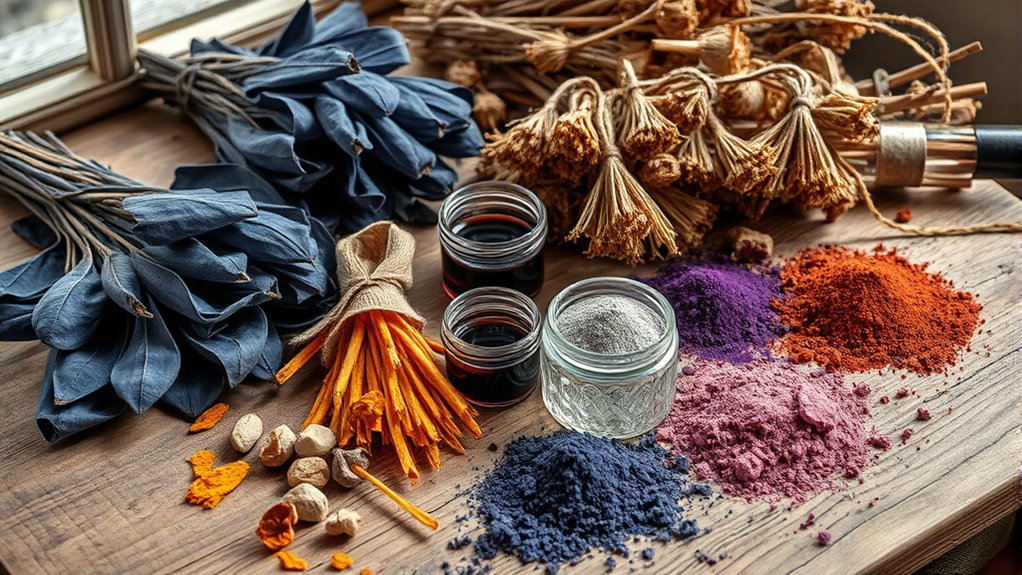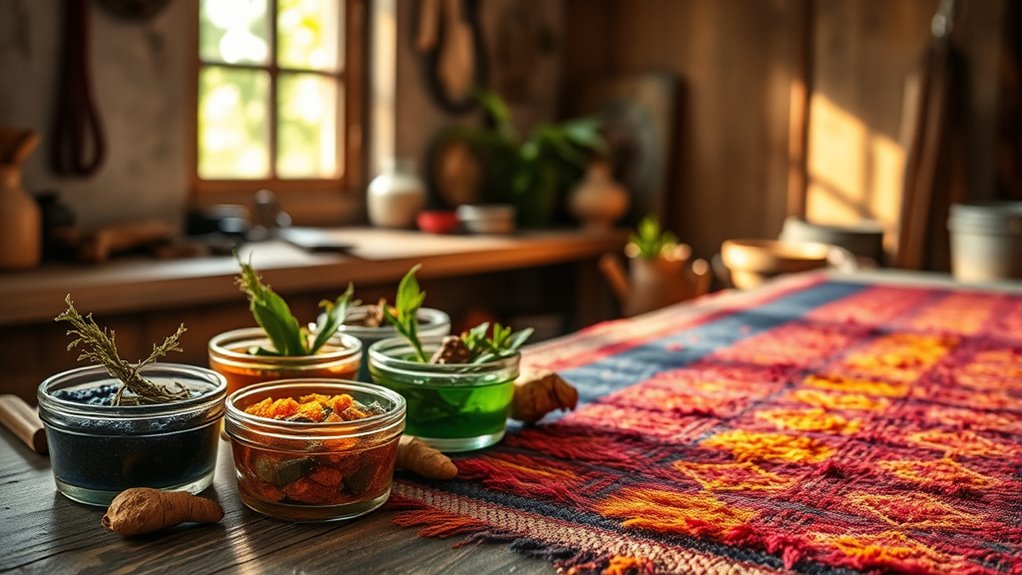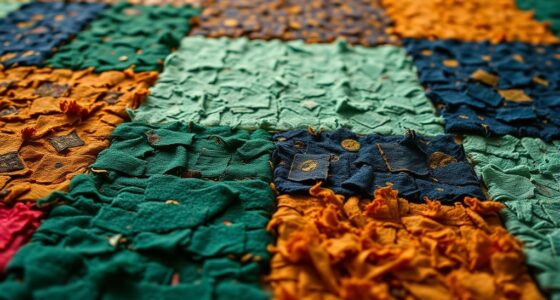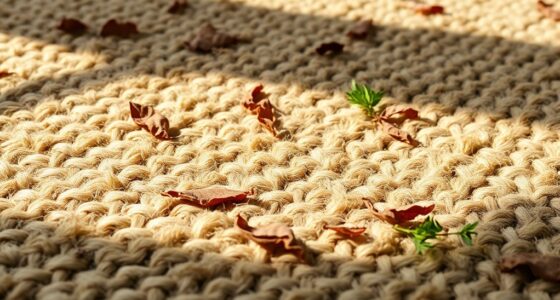Sustainable dyeing uses natural plant extracts like indigo, madder, and turmeric, alongside minerals such as alum and iron, to color rugs eco-friendly. You soak fibers in these dyes or mordants derived from local materials, avoiding harmful chemicals. This process creates vibrant, durable colors that support biodiversity and reduce pollution. By choosing natural dyes, you promote eco-conscious practices while enjoying unique shades and textures—if you continue exploring, you’ll discover even more about eco-friendly rug artistry.
Key Takeaways
- Natural dyes for rugs are extracted from local plants like indigo, madder, and turmeric, promoting sustainable sourcing.
- Eco-friendly mordants such as alum, iron, and tannins enhance colorfastness without environmental harm.
- The dyeing process involves pre-treating fibers and immersing them in plant-based dye baths for vibrant, nuanced colors.
- Using minerals and plant materials reduces toxic chemical use, lowering pollution and preserving biodiversity.
- Natural dyeing offers a wide spectrum of earthy and vibrant shades, encouraging eco-conscious craftsmanship.

Sustainable dyeing is gaining popularity as a responsible alternative to traditional methods that often harm the environment. When you choose natural dye extraction, you tap into a process that uses plant materials, minerals, and organic substances to produce vibrant colors without the toxic chemicals associated with synthetic dyes. This approach not only reduces pollution but also preserves biodiversity, since many plants used for dyeing can be harvested sustainably. You might start by gathering leaves, roots, or bark from local plants known for their color properties, such as indigo, madder, or turmeric. These natural sources can be simmered or soaked to release their pigments, creating dyes that are both eco-friendly and unique to your local environment.
In addition to selecting the right plant materials, you’ll want to use eco friendly mordants, which are substances that help fix dyes onto fibers. Traditional mordants like chrome or heavy metals are harmful to both the environment and human health, so opting for alternatives like alum, iron, or tannins is essential for sustainable practices. These eco friendly mordants not only enhance colorfastness but do so without poisoning waterways or risking your health. When you mordant your fabric with natural options, you’re ensuring that the entire dyeing process aligns with eco-conscious principles. This is especially important if you’re dyeing textiles for rugs, as long-lasting colors reduce the need for re-dyeing or replacement, contributing to less waste over time.
Furthermore, understanding the benefits of natural dyes can motivate you to adopt sustainable dyeing practices that are beneficial for both the environment and your craft. The process of natural dyeing involves a careful balance of preparation and patience. You’ll want to pre-treat your fibers with mordants first, ensuring they absorb the dye evenly. Then, by immersing your fabric into the dye bath, you allow the fibers to soak up the natural pigments. The resulting colors tend to be softer and more nuanced than synthetic dyes, often with a subtle variation that adds character to your finished rug. As you experiment, you might find that different mordants or plant sources produce a wide spectrum of shades, from earthy browns to vibrant reds and deep blues. This versatility makes natural dyeing not only environmentally responsible but also creatively satisfying.
Frequently Asked Questions
How Long Do Natural Dyes Typically Last Compared to Synthetic Dyes?
Natural dyes generally have a shorter dye longevity than synthetic dyes, typically lasting around 1 to 3 years with proper care. You might notice natural colors fading faster, especially with exposure to sunlight and washing. Regarding colorfastness comparison, synthetic dyes usually offer more durability and resistance to fading over time. However, with gentle handling and minimal exposure to harsh conditions, natural dyes can maintain vibrant hues longer.
Are There Any Health Risks Associated With Natural Dye Extraction?
You might wonder if natural dye extraction poses health risks. Generally, natural dyes have low toxicity concerns, making them safer than synthetic options. However, you should be aware of allergy risks, as some plant or mineral extracts can cause allergic reactions in sensitive individuals. Always test a small area first, and wear gloves during extraction to minimize skin irritation. Proper handling reduces potential health issues associated with natural dyeing.
Can Natural Dyes Be Used on Synthetic Fibers Effectively?
Yes, natural dyes can be used effectively on synthetic fibers, but plant chemistry and fiber compatibility are key. You’ll need to select dyes with chemical properties that bond well with synthetic fibers like polyester or nylon. Pre-treatment of fibers enhances dye absorption, ensuring vibrant, long-lasting colors. By understanding how plant chemistry interacts with different synthetic materials, you can achieve beautiful, sustainable results that last.
What Are the Environmental Impacts of Mining Minerals for Dyes?
Mining minerals for dyes can cause significant environmental impacts. You should know that mineral extraction often leads to ecological disturbance, damaging ecosystems and wildlife habitats. It can also result in soil erosion, water pollution, and increased carbon emissions. When you choose mineral-based dyes, you’re indirectly supporting practices that may harm the environment. Being aware of these impacts helps you make more sustainable decisions for rug dyeing and reduces your ecological footprint.
How Do Climate Conditions Affect the Dyeing Process With Plants and Minerals?
Climate conditions are like a delicate dance, directly influencing your dyeing process with plants and minerals. Climate variability and seasonal effects can alter color intensity, extraction efficiency, and dye stability. Warmer temperatures may enhance dye uptake, while unpredictable weather can cause inconsistencies. To achieve vibrant, lasting colors, you must adapt your methods to these shifting patterns, embracing nature’s rhythm rather than fighting against it.
Conclusion
By choosing plant and mineral dyes, you’re not just coloring rugs—you’re making a statement that sustainability matters. These natural methods prove you don’t have to reinvent the wheel to make a difference; you just need to be mindful and intentional. When you opt for eco-friendly dyes, you’re helping to preserve the environment and honoring tradition. Remember, sometimes the best things in life are right under your nose, waiting to be uncovered through mindful choices.









